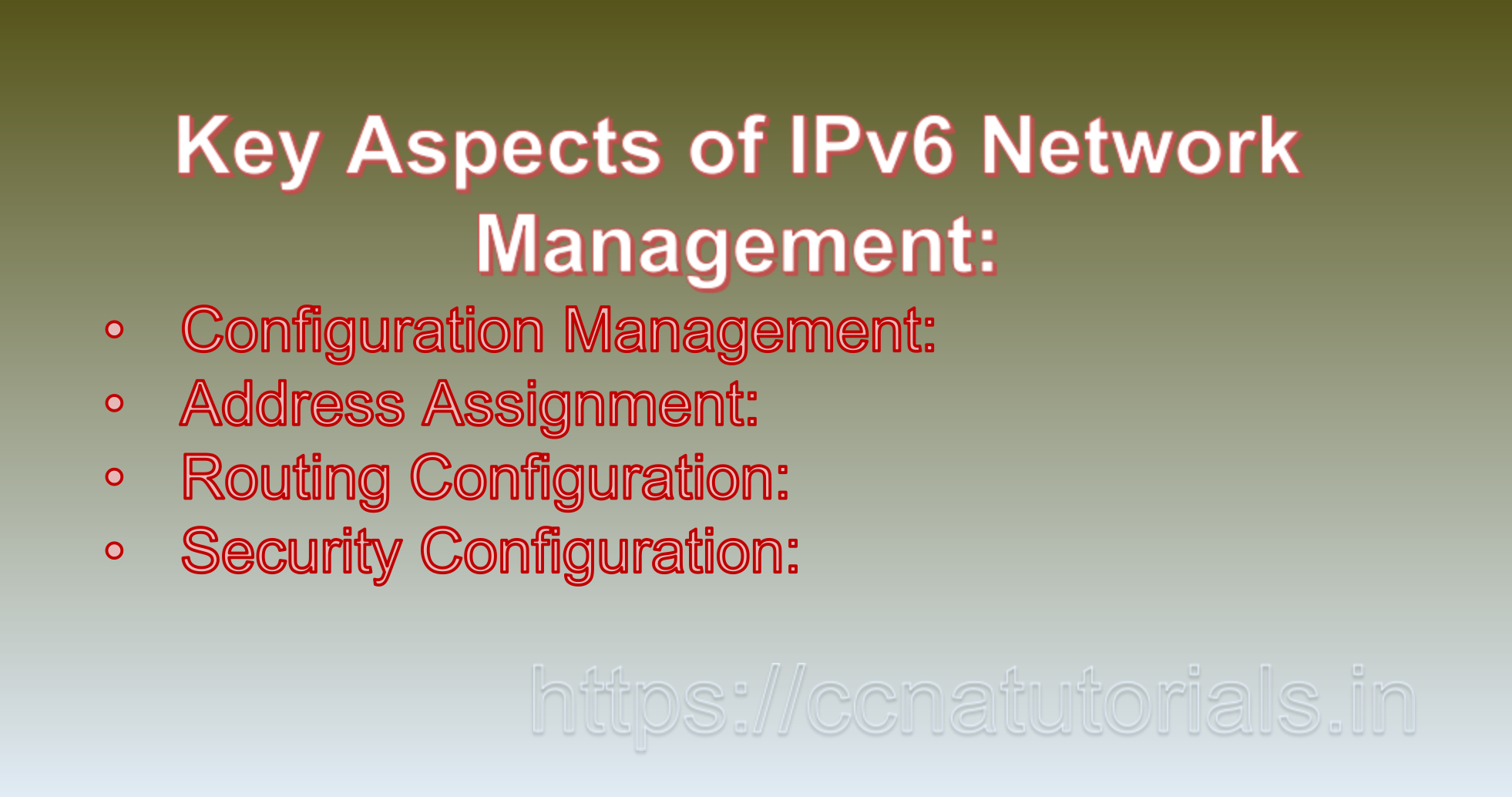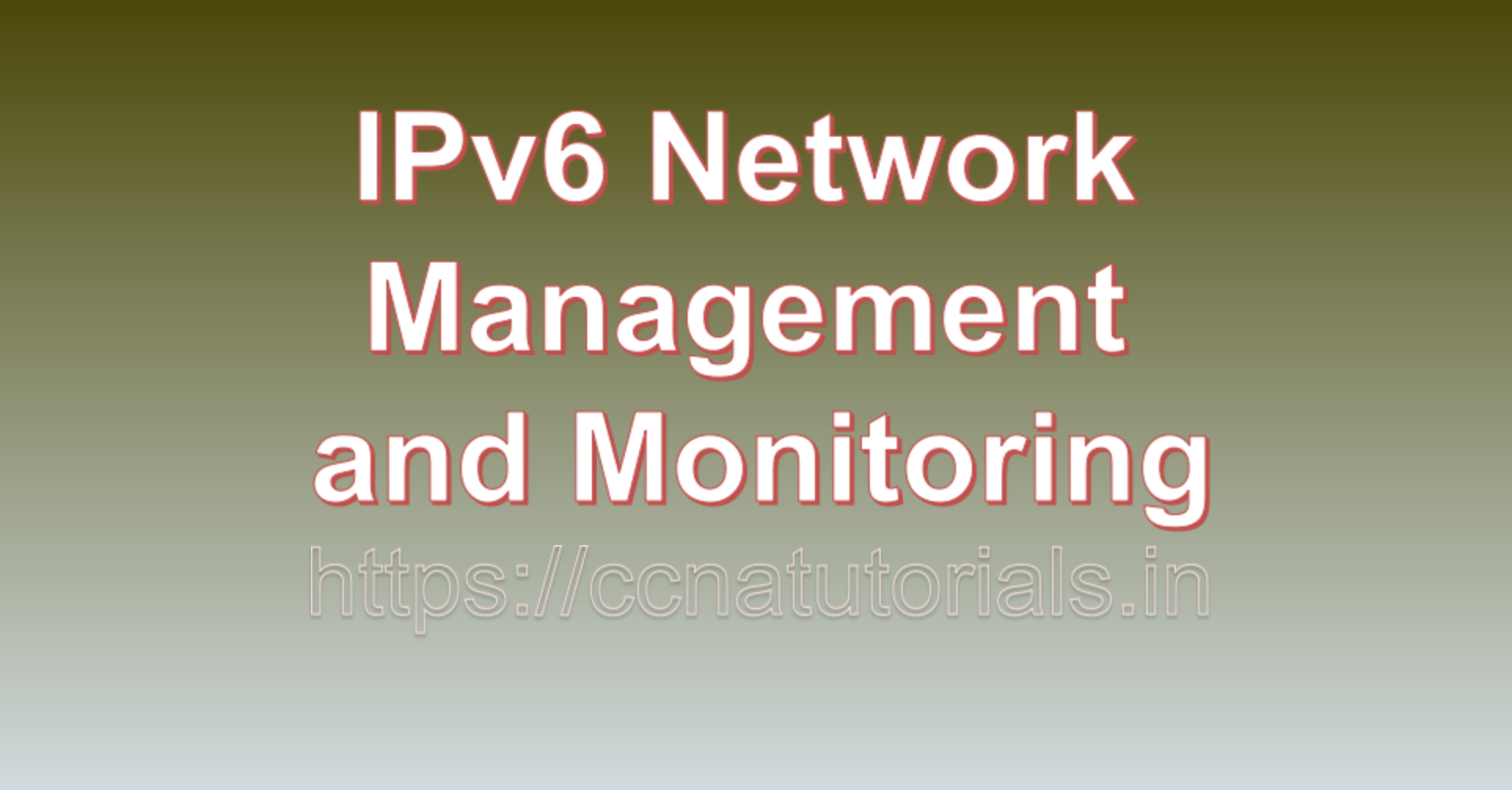Contents of this article
In this article, I describe IPv6 Network Management and Monitoring: Ensuring Efficient Operations in the IPv6 Era. IPv6 network management and monitoring are crucial components of maintaining a well-functioning network infrastructure in the IPv6 environment. As organizations transition to IPv6, they need to adapt their network management practices to accommodate the new protocol’s characteristics and features. This article provides an overview of IPv6 network management and monitoring, highlighting the key considerations, challenges, and best practices to ensure efficient operations.
IPv6 Network Management:
IPv6 network management involves the processes, tools, and methodologies used to configure, monitor, troubleshoot, and optimize an IPv6-based network infrastructure. It encompasses a wide range of activities aimed at ensuring the reliability, security, and performance of network resources.
Key Aspects of IPv6 Network Management:
1. Configuration Management:
IPv6 network administrators must configure devices, routers, and services with appropriate IPv6 addresses, routing information, and security policies. IPv6 addresses are longer and use hexadecimal notation, requiring careful planning and documentation.
2. Address Assignment:
Organizations need to adopt address assignment techniques that match the scalability and flexibility of IPv6. Dynamic Host Configuration Protocol version 6 (DHCPv6) and Stateless Address Autoconfiguration (SLAAC) are commonly used for assigning IPv6 addresses to devices.
3. Routing Configuration:
IPv6 routing protocols, such as OSPFv3 and BGP, must be configured to handle IPv6 routing information. Routing decisions, including route selection and convergence, are vital for efficient packet forwarding.
4. Security Configuration:
Security policies and mechanisms should be adapted to IPv6’s unique characteristics. Firewalls, intrusion detection systems, and intrusion prevention systems need to be configured to handle both IPv4 and IPv6 traffic.
IPv6 Network Monitoring:
IPv6 network monitoring involves continuously observing and analyzing the performance, availability, and security of an IPv6-based network. Effective monitoring ensures that network administrators can proactively identify and address issues before they impact network operations.
Key Aspects of IPv6 Network Monitoring:
1. Traffic Analysis:
Network monitoring tools analyze IPv6 traffic patterns, allowing administrators to identify abnormal behavior, bottlenecks, and potential security threats.
2. Performance Metrics:
Monitoring tools provide metrics such as latency, throughput, and packet loss for IPv6 traffic. These metrics help assess the quality of service and identify areas for optimization.
3. Security Monitoring:
Intrusion detection and prevention systems monitor IPv6 traffic for signs of malicious activity or unauthorized access attempts. IPv6-specific attack vectors need to be considered.
4. Device Health:
Monitoring tools track the health and status of IPv6-enabled devices, including routers, switches, and servers. This helps ensure that devices are functioning properly and are not impacting network performance.
Challenges in IPv6 Network Management and Monitoring:
1. Lack of Familiarity:
IPv6 introduces new concepts, addressing formats, and routing mechanisms that network administrators may be less familiar with compared to IPv4.
2. Dual-Stack Complexity:
Operating in a dual-stack environment requires managing both IPv4 and IPv6 configurations, adding complexity to network management tasks.
3. Security Considerations:
IPv6 brings new security challenges, such as Neighbor Discovery vulnerabilities and potential misconfigurations that attackers can exploit.
4. Monitoring Tools:
Some legacy network monitoring tools designed for IPv4 may not fully support IPv6 monitoring, necessitating the adoption of tools that offer comprehensive IPv6 analysis.
IPv6 Network Management and Monitoring Best Practices:
1. Planning and Documentation:
Develop a comprehensive IPv6 network management plan that outlines configuration, addressing, routing, and security policies. Thoroughly document all IPv6-related configurations.
2. Training:
Provide training to network administrators to familiarize them with IPv6 concepts, addressing, routing protocols, and security considerations.
3. Automation:
Use automation tools to streamline repetitive IPv6 network management tasks, reducing the likelihood of human errors.
4. Testing:
Regularly test IPv6 configurations, routing, and security mechanisms to ensure they are functioning as intended.
5. Regular Monitoring:
Deploy IPv6-compatible network monitoring tools that can provide visibility into both IPv4 and IPv6 traffic. Regularly review monitoring data to identify trends and potential issues.
6. Security Updates:
Stay informed about IPv6-related security vulnerabilities and updates. Apply patches and updates to devices and monitoring tools to address known security risks.

In short IPv6 Network Management and Monitoring
IPv6 network management and monitoring are vital for ensuring the efficient and secure operation of IPv6-based network infrastructures. As organizations transition to IPv6, they must adapt their network management practices to account for IPv6-specific configurations, addressing, routing, and security considerations. By following best practices, leveraging automation, and using monitoring tools that support IPv6, organizations can successfully manage, monitor, and optimize their IPv6 networks, providing reliable connectivity and a seamless user experience in the evolving digital landscape.
IPv6 Network Management and Monitoring: Ensuring Efficient and Reliable Operations
IPv6 network management and monitoring are essential components of maintaining the health, performance, and security of IPv6-enabled networks. As organizations transition to IPv6 to accommodate the growing number of Internet-connected devices, effective management and monitoring practices become crucial. This article provides an overview of IPv6 network management and monitoring, highlighting their significance and key considerations.
IPv6 Network Management:
IPv6 network management involves the administration, configuration, monitoring, and maintenance of IPv6-enabled devices, services, and infrastructure. It encompasses a range of activities aimed at ensuring the smooth operation of the network while addressing challenges specific to IPv6 deployment.
Key Aspects of IPv6 Network Management:
1. Device Configuration:
Configure routers, switches, firewalls, and other network devices to support IPv6. Ensure that device settings align with the organization’s IPv6 addressing plan and security policies.
2. Addressing Plan:
Develop a comprehensive IPv6 addressing plan that optimizes address space usage, adheres to addressing best practices, and accommodates future growth.
3. Security Measures:
Implement security practices tailored to IPv6, including firewall rules, intrusion detection systems, and encryption protocols. Address potential vulnerabilities specific to IPv6.
4. Traffic Monitoring:
Employ network monitoring tools to track IPv6 traffic patterns, bandwidth utilization, and performance metrics. Monitor traffic to identify anomalies or potential issues.
5. Network Troubleshooting:
Develop procedures for troubleshooting IPv6-related problems. Determine strategies for diagnosing connectivity issues, performance bottlenecks, and configuration errors.
6. Documentation:
Maintain accurate documentation of IPv6 network configurations, addressing plans, security measures, and monitoring practices. This documentation aids in troubleshooting and future planning.
IPv6 Network Monitoring:
IPv6 network monitoring involves the continuous observation of network traffic, performance metrics, and device health to detect and address issues in real time. Monitoring tools provide insights into network behavior, facilitating timely responses to anomalies and ensuring optimal performance.
Key Aspects of IPv6 Network Monitoring:
1. Traffic Analysis:
Monitor IPv6 traffic patterns to identify trends, anomalies, and potential security threats. Track sources of traffic, protocols used, and application usage.
2. Performance Metrics:
Monitor network performance metrics, including latency, jitter, and packet loss. This helps ensure the quality of service for real-time applications like VoIP and video conferencing.
3. Bandwidth Utilization:
Track the utilization of IPv6 bandwidth to identify congestion points, predict capacity requirements, and optimize network resources.
4. Device Health:
Monitor the health of IPv6-enabled devices, such as routers and switches, to detect hardware failures, resource exhaustion, and configuration errors.
5. Security Monitoring:
Implement intrusion detection and prevention systems to monitor IPv6 traffic for signs of unauthorized access, malware, or suspicious activities.
6. Alerts and Notifications:
Set up alerts and notifications that trigger when predefined thresholds are breached. This ensures prompt action in response to critical events.
Significance of IPv6 Network Management and Monitoring:
1. Operational Efficiency: Effective network management and monitoring streamline network operations, enabling proactive troubleshooting, configuration management, and capacity planning.
2. Performance Optimization: Monitoring network performance metrics allows organizations to identify and address performance bottlenecks, ensuring optimal user experience.
3. Security Enhancement: IPv6 network monitoring helps detect security threats, unauthorized access attempts, and vulnerabilities, allowing timely responses to mitigate risks.
4. Resource Utilization: Monitoring IPv6 traffic and bandwidth utilization assists in efficient allocation of network resources, preventing congestion and optimizing performance.
Conclusion IPv6 Network Management and Monitoring:
IPv6 network management and monitoring are crucial for organizations adopting IPv6 to ensure the reliability, performance, and security of their network infrastructure. By implementing effective management practices, organizations can configure devices, address security concerns, and troubleshoot issues specific to IPv6 deployment. Network monitoring tools provide valuable insights into network behavior, traffic patterns, and performance metrics, enabling organizations to proactively address anomalies and optimize resource utilization. As the Internet landscape evolves and the demand for IPv6 connectivity grows, robust network management and monitoring practices are essential for maintaining efficient and reliable operations in IPv6-enabled networks. You may contact us or drop a comment below for any query related to this article.






